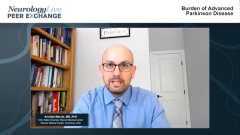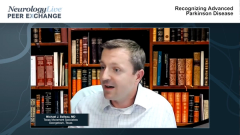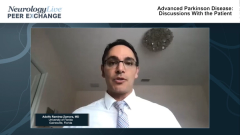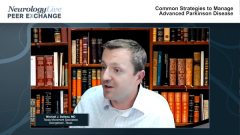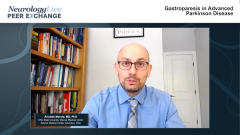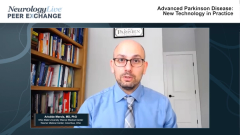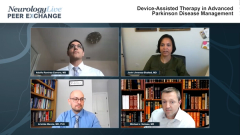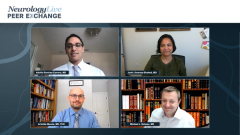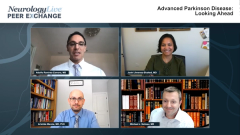
Advanced Parkinson Disease: New Technology in Practice
A discussion about when a clinician should consider discussing a device-assisted therapy with a patient with advanced Parkinson disease.
Episodes in this series

Adolfo Ramirez-Zamora, MD: Ari, what do you do in your practice? You are a technology guy. I’m sure you’re using a sensor.
Aristide Merola, MD, PhD: I was hoping you would ask that. What are the challenges with sensors? The first one is that if you think about using only one sensor, you can see what’s happening in one wrist. But we know that our patients may have a tremor in one hand and dyskinesia in the other, and we cannot really capture the entire complexity of the motor behavior just with one sensor. So that’s problem number 1. Problem number 2, we have all of these data. I personally ask my patients, for instance, to keep diaries of their blood pressure, and they come with 10 pages of blood pressure measurements. Do I really read them all? Not really. I basically skim them. I’ve realized that when we have too much data, we don’t really analyze all of the data, especially if we have reliable patients, because they can basically give us a good synthesis of what’s going on. They just need to know that when they feel lightheaded, they have to measure their blood pressure standing. They don’t really have to do it 1,000 times. They do it 2 different times as soon as they identify the pattern.
In terms of how to integrate technology in monitoring, there are 2 different ways. One way is to give them a wearable and basically try to track what we can get out of that wearable. Another approach, which is also under study, is the use of smart homes. So rather than hooking wearables on the patient, actually putting devices into the house, and trying to capture through these devices some of the motor behavior of patients. Of course, this is just experimental right now. It’s not feasible to put this into every single patient’s house, but that’s probably where we’re going. We’re going toward the point at which the house can track the movements of patients and provide us maybe not all of the data, but in certain situations like risk of falling or certain aspects. Technology is going really fast, and exactly which is the way to tackle neurodegenerative diseases is still not clear, but it’s an exciting moment for sure.
Michael J. Soileau, MD: Ari, I had a patient fall in her home and use one of those devices to call 911, wound up saving her life. So it’s very exciting to me to think of what’s ahead. I think this is a really, really exciting time.
Aristide Merola, MD, PhD: Another point, in which actually I have to say that, Joohi and Adolfo, you’re probably even bigger experts, is the new deep-brain stimulation and in-brain sensing. So having the ability, rather than measuring the entire body, to measure what’s happening inside a specific region of the brain. And we know that if there is a hypersynchrony in one specific band, the beta-band, this means that the patient is underdosed. If we have a hypersynchrony in the gamma-band, they may be overdosed. So that might be a different approach. Joohi, what do you think?
Joohi Jimenez-Shahed, MD: That’s music to my ears. I love this conversation. It’s really fascinating, and I’ll give you a case example of a patient that I saw recently who had one of these devices in, and we were able to record the brain signals at the same time as we were delivering the stimulation. There were a couple of things that were very fascinating about this. One of the functionalities of this device is a timeline view, so you can see from day to day what’s going on with the patient. And, Ari, as you mentioned, the beta-band is of particular interest in Parkinson disease because we know when the beta-band is present, it’s usually a sign that the patient’s symptoms are less well controlled. And when it’s absent, that they’re better controlled.
So, we were going back through her timeline view of the sensing device, and she’s one of these patients who really likes to take medication. She’s definitely got that anxiety about it wearing off, and is she going to be out somewhere and not be able to walk? And so she overmedicates, unfortunately, is the truth. But we were able to go through this timeline view day by day and talk to her. Because we could see the beta-band coming, going, coming, and going, and [we were] talking about “What are you doing with your medications? What symptoms were you having during this period of time that made you feel like you needed to take the medication?” More often than not, it correlated with the fluctuation in that beta-band, and so we were very much able to have this directed conversation about what she might need to do differently with her medications as a result of being able to see that signal. So it was really amazing.
Adolfo Ramirez-Zamora, MD: That’s great. I think in the not-so-distant future, maybe we can have a combination of both. Maybe we could have a combination of peripheral sensors that will allow us to precisely determine symptoms when they’re wearing off, when they get dyskinetic, maybe a different system which would allow us to monitor gait and balance. I mean, balance is a combination of different factors, but maybe we can incorporate different sensors and then finally record unique, patient-specific fluctuating active signal changes in the brain that may allow us to dictate treatments better. So it sounds a little futuristic, but it’s not that far-fetched if you really think about it. We have the technology to record live brain activity at the same time that we stimulate the brain. We now understand that these signals correlate with the specific symptoms. And now we also have the ability to, maybe not perfectly, but we can get an idea about what happens or monitor objectively, with some of these sensors, some of the patient’s symptoms. So this is really a great discussion.
Thank you all for watching this Neurology Live® Peer Exchange. If you enjoyed the content, please subscribe to our e-newsletter to receive upcoming Peer Exchanges and other great content right in your in-box. Thank you so much.
Transcript Edited for Clarity
Newsletter
Keep your finger on the pulse of neurology—subscribe to NeurologyLive for expert interviews, new data, and breakthrough treatment updates.

